- 1达梦数据库修改字段长度_政策搞三调,数据库标准调整你不能忽略!
- 2Android Studio说:使用HashMap不如使用SparseArray?_androidstudio中使用map
- 3DDR4时序标准规范(二)_ddr4时序参数表
- 4hiprint在Vue.js+Element UI的使用_hiprint官网
- 5【DataWhale学习】用免费GPU线上跑chatGLM、SD项目实践
- 62024年最全C++程序设计选择题_c++选择题(2),2024年最新新鲜出炉的蚂蚁金服面经
- 7AQS阻塞队列_aqs为什么维护唤醒后是单向队列
- 8毕业设计:基于深度学习的音乐推荐系统 人工智能 python_深度学习推荐系统python实现
- 9大数据Flink实时计算技术_flink实时任务计算指标数据
- 10Iphone11 15.5 A13处理器 TrollStore安装
CNN做时间序列预测_6 种用 LSTM 做时间序列预测的模型结构 - Keras 实现
赞
踩

LSTM(Long Short Term Memory Network)长短时记忆网络,是一种改进之后的循环神经网络,可以解决 RNN 无法处理长距离的依赖的问题,在时间序列预测问题上面也有广泛的应用。
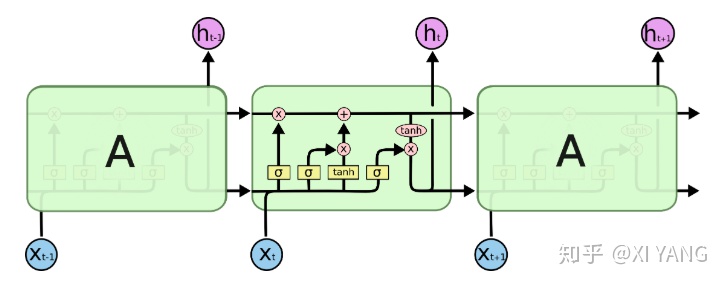
今天我们根据问题的输入输出模式划分,来看一下几种时间序列问题所对应的 LSTM 模型结构如何实现。

1. Univariate
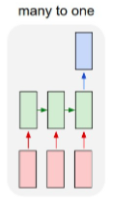
Univariate 是指:
input 为多个时间步, output 为一个时间的问题。
数例:
- 训练集:
- X, y
- 10, 20, 30 40
- 20, 30, 40 50
- 30, 40, 50 60
- …
-
-
- 预测输入:
- X,
- 70, 80, 90
模型的 Keras 代码:
- # define model【Vanilla LSTM】
-
- model = Sequential()
- model.add( LSTM(50, activation='relu', input_shape = (n_steps, n_features)) )
- model.add( Dense(1) )
- model.compile(optimizer='adam', loss='mse')
-
- n_steps = 3
- n_features = 1
其中:
n_steps 为输入的 X 每次考虑几个时间步 n_features 为每个时间步的序列数
这个是最基本的模型结构,我们后面几种模型会和这个进行比较。
2. Multiple Input

Multiple Input 是指:
input 为多个序列, output 为一个序列的问题。
数例:
- 训练集:
- X, y
- [[10 15]
- [20 25]
- [30 35]] 65
- [[20 25]
- [30 35]
- [40 45]] 85
- [[30 35]
- [40 45]
- [50 55]] 105
- [[40 45]
- [50 55]
- [60 65]] 125
- …
-
-
- 预测输入:
- X,
- 80, 85
- 90, 95
- 100, 105

即数据样式为:
- in_seq1: [10, 20, 30, 40, 50, 60, 70, 80, 90]
- in_seq2: [15, 25, 35, 45, 55, 65, 75, 85, 95]
-
- out_seq: [in_seq1[i]+in_seq2[i] for i in range(len(in_seq1))]
模型的 Keras 代码:
- # define model【Vanilla LSTM】
- model = Sequential()
- model.add(LSTM(50, activation='relu', input_shape=(n_steps, n_features)))
- model.add(Dense(1))
- model.compile(optimizer='adam', loss='mse')
-
- n_steps = 3
- # 此例中 n features = 2,因为输入有两个并行序列
- n_features = X.shape[2]
其中:
n_steps 为输入的 X 每次考虑几个时间步 n_features 此例中 = 2,因为输入有两个并行序列
和 Univariate 相比:
模型的结构代码是一样的,只是在 n_features = X.shape[2],而不是 1.
3. Multiple Parallel

Multiple Parallel 是指:
input 为多个序列, output 也是多个序列的问题。
数例:
- 训练集:
- X, y
- [[10 15 25]
- [20 25 45]
- [30 35 65]] [40 45 85]
- [[20 25 45]
- [30 35 65]
- [40 45 85]] [ 50 55 105]
- [[ 30 35 65]
- [ 40 45 85]
- [ 50 55 105]] [ 60 65 125]
- [[ 40 45 85]
- [ 50 55 105]
- [ 60 65 125]] [ 70 75 145]
- …
-
-
- 预测输入:
- X,
- 70, 75, 145
- 80, 85, 165
- 90, 95, 185

模型的 Keras 代码:
- # define model【Vanilla LSTM】
- model = Sequential()
- model.add(LSTM(100, activation='relu', return_sequences=True, input_shape=(n_steps, n_features)))
- model.add(Dense(n_features))
- model.compile(optimizer='adam', loss='mse')
-
- n_steps = 3
- # 此例中 n features = 3,因为输入有3个并行序列
- n_features = X.shape[2]
其中:
n_steps 为输入的 X 每次考虑几个时间步 n_features 此例中 = 3,因为输入有 3 个并行序列
和 Univariate 相比:
模型结构的定义中,多了一个 return_sequences=True,即返回的是序列, 输出为 Dense(n_features),而不是 1.
4. Multi-Step
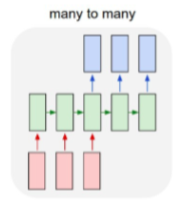
Multi-Step 是指:
input 为多个时间步, output 也是多个时间步的问题。
数例:
- 训练集:
- X, y
- [10 20 30] [40 50]
- [20 30 40] [50 60]
- [30 40 50] [60 70]
- [40 50 60] [70 80]
- …
-
-
- 预测输入:
- X,
- [70, 80, 90]
模型的 Keras 代码:
- # define model【Vanilla LSTM】
- model = Sequential()
- model.add(LSTM(100, activation='relu', return_sequences=True, input_shape=(n_steps_in, n_features)))
- model.add(LSTM(100, activation='relu'))
- model.add(Dense(n_steps_out))
- model.compile(optimizer='adam', loss='mse')
-
- n_steps_in, n_steps_out = 3, 2
- n_features = 1
其中:
n_steps_in 为输入的 X 每次考虑几个时间步 n_steps_out 为输出的 y 每次考虑几个时间步 n_features 为输入有几个序列
和 Univariate 相比:
模型结构的定义中,多了一个 return_sequences=True,即返回的是序列, 而且 input_shape=(n_steps_in, n_features) 中有代表输入时间步数的 n_steps_in, 输出为 Dense(n_steps_out),代表输出的 y 每次考虑几个时间步.
当然这个问题还可以用 Encoder-Decoder 结构实现:
- # define model【Encoder-Decoder Model】
- model = Sequential()
- model.add(LSTM(100, activation='relu', input_shape=(n_steps_in, n_features)))
- model.add(RepeatVector(n_steps_out))
- model.add(LSTM(100, activation='relu', return_sequences=True))
- model.add(TimeDistributed(Dense(1)))
- model.compile(optimizer='adam', loss='mse')
5. Multivariate Multi-Step
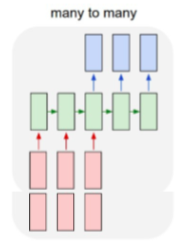
Multivariate Multi-Step 是指:
input 为多个序列, output 为多个时间步的问题。
数例:
- 训练集:
- X, y
- [[10 15]
- [20 25]
- [30 35]] [65
- 85]
- [[20 25]
- [30 35]
- [40 45]] [ 85
- 105]
- [[30 35]
- [40 45]
- [50 55]] [105
- 125]
- …
-
-
- 预测输入:
- X,
- [40 45]
- [50 55]
- [60 65]

模型的 Keras 代码:
- # define model
- model = Sequential()
- model.add(LSTM(100, activation='relu', return_sequences=True, input_shape=(n_steps_in, n_features)))
- model.add(LSTM(100, activation='relu'))
- model.add(Dense(n_steps_out))
- model.compile(optimizer='adam', loss='mse')
-
- n_steps_in, n_steps_out = 3, 2
- # 此例中 n features = 2,因为输入有2个并行序列
- n_features = X.shape[2]
其中:
n_steps_in 为输入的 X 每次考虑几个时间步 n_steps_out 为输出的 y 每次考虑几个时间步 n_features 为输入有几个序列,此例中 = 2,因为输入有 2 个并行序列
和 Univariate 相比:
模型结构的定义中,多了一个 return_sequences=True,即返回的是序列, 而且 input_shape=(n_steps_in, n_features) 中有代表输入时间步数的 n_steps_in, 输出为 Dense(n_steps_out),代表输出的 y 每次考虑几个时间步, 另外 n_features = X.shape[2],而不是 1, 相当于是 Multivariate 和 Multi-Step 的结构组合起来。
6. Multiple Parallel Input & Multi-Step Output
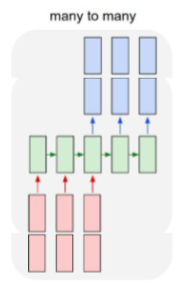
Multiple Parallel Input & Multi-Step Output 是指:
input 为多个序列, output 也是多个序列 & 多个时间步的问题。
数例:
- 训练集:
- X, y
- [[10 15 25]
- [20 25 45]
- [30 35 65]] [[ 40 45 85]
- [ 50 55 105]]
- [[20 25 45]
- [30 35 65]
- [40 45 85]] [[ 50 55 105]
- [ 60 65 125]]
- [[ 30 35 65]
- [ 40 45 85]
- [ 50 55 105]] [[ 60 65 125]
- [ 70 75 145]]
- …
-
-
- 预测输入:
- X,
- [[ 40 45 85]
- [ 50 55 105]
- [ 60 65 125]]

模型的 Keras 代码:
- # define model【Encoder-Decoder model】
- model = Sequential()
- model.add(LSTM(200, activation='relu', input_shape=(n_steps_in, n_features)))
- model.add(RepeatVector(n_steps_out))
- model.add(LSTM(200, activation='relu', return_sequences=True))
- model.add(TimeDistributed(Dense(n_features)))
- model.compile(optimizer='adam', loss='mse')
-
- n_steps_in, n_steps_out = 3, 2
- # 此例中 n features = 3,因为输入有3个并行序列
- n_features = X.shape[2]
其中:
n_steps_in 为输入的 X 每次考虑几个时间步 n_steps_out 为输出的 y 每次考虑几个时间步 n_features 为输入有几个序列
这里我们和 Multi-Step 的 Encoder-Decoder 相比:
二者的模型结构,只是在最后的输出层参数不同, TimeDistributed(Dense(n_features)) 而不是 Dense(1)。
好啦,这几种时间序列的输入输出模式所对应的代码结构就是这样,如果您还有更有趣的,欢迎补充!
大家好! 我是 不会停的蜗牛 Alice, 喜欢人工智能,没事儿写写机器学习干货, 欢迎关注我!


